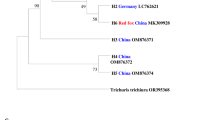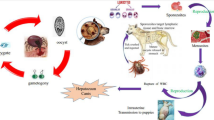Summary
Sporozoites of Eimeria acervulina were observed in macrophages of the intestinal epithelium 5 and 6 days post-infection. These sporozoites lay within a well developed parasitophorous vacuole, were normal in structure and showed no signs of development. Macrophages harbouring sporozoites showed considerable structural changes, most pronounced being an absence of lysosomes, an enlarged nucleolus and extensive proliferation of the Golgi complex and endoplasmic reticulum. Possible mechanisms of survival and transport of sporozoites to preferred sites of development are discussed.
Similar content being viewed by others
Abbreviations
- ER:
-
Endoplasmic reticulum
- ERM:
-
Endoplasmic reticulum of macrophage
- GOM:
-
Golgi zone of macrophage
- INM:
-
Invaginations of macrophage cell membrane
- LM:
-
Lipid globule of macrophage
- LYM:
-
Lysosomes of macrophage
- MI:
-
Mitochondria
- MIM:
-
Mitochondria of macrophage
- MN:
-
Micronemes
- MP:
-
Micropore
- N:
-
Nucleus
- NM:
-
Nucleus of macrophage
- PO:
-
Rhoptries (paired organelles)
- PV:
-
Parasitophorous vacuole
- RB:
-
Refractile body
- V:
-
Vacuole
References
Anderson, S. E., Remington, J. S.: Effect of normal and activated human macrophages on Toxoplasma gondii. J. exp. Med. 139, 1154–1174 (1974)
Bedrnik, P.: Cultivation of Eimeria tenella in tissue cultures. II. Factors influencing a further development of second generation merozoites in tissue culture. Acta protozool. 7, 253–261 (1970)
Bergmann, V.: Elektronenmikroskopische Untersuchungen zur Pathogenese der Blinddarmkokzidiose der Hühnerküken. Arch. exp. Vet. Med. 24, 1169–1184 (1970)
Challey, J. R., Burns, W. M.: The invasion of coecal mucosa by Eimeria tenella sporozoites and their transport by macrophages. J. Protozool. 6, 238–241 (1959)
Doran, D. J.: The migration of Eimeria acervulina sporozoites to the duodenal gland of Lieberkühn. J. Protozool. 13, 27–33 (1966)
Doran, D. J.: Increasing the yield of Eimeria tenella oocysts in cell culture. J. Parasit. 57, 891–900 (1971)
Doran, D. J.: Cultivation of coccidia in avian embryos and cell culture. In: D. M. Hammond and P. L. Long, eds., The coccidia, p. 183–252. Baltimore: University Park Press; London: Butterworths 1973
El-Kasaby, A., Sykes, A. H.: The role of chicken macrophages in the parenteral excystation of Eimeria acervulina. Parasitology 66, 231–239 (1973)
Fayer, R., Hammond, D. M.: Development of first generation schizonts of Eimeria bovis in cultured bovine cells. J. Protozool. 14, 764–772 (1967)
Gresham, G. A., Cruickshank, J. G.: Protein synthesis in macrophages containing Eimeria tenella. Nature (Lond.) 184, 1153 (1959)
Hammond, D. M., Fayer, R., Miner, M. L.: Further studies on in vitro development of Eimeria bovis and attempts to obtain second generation schizonts. J. Protozool. 16, 298–302 (1969)
Huff, D., Clark, D. T.: Cellular aspects of the resistance of chicken to Eimeria tenella infections. J. Protozool. 7, 35–39 (1970)
Jones, J. C., Hirsch, J. G.: The interaction between Toxoplasma gondii and mammalian cells. II. The absence of lysosomal fusion with phagocytic vacuoles containing living parasites. J. exp. Med. 136, 1173–1194 (1972)
Lee, D. L., Long, P. L.: An electron microscopical study of Eimeria tenella grown in the liver of the chick embryo. Int. J. Parasit. 2, 55–58 (1972)
Long, P. L.: In vitro culture of Eimeria tenella. J. Parasit. 56 (No. 4, sect. 2), 214–215 (1970)
Long, P. L.: The growth of Eimeria in cultured cells and in chicken embryos: A review. In: Proceedings of the symposium on coccidia and related organisms, p. 57–82. Guelph, Ontario: University of Guelph 1973
Michael, E.: Fine structure and development of schizonts, merozoites and macrogamonts of Eimeria acervulina in the goblet cells of the duodenal epithelium of experimentally infected birds. Parasitology 70, 223–229 (1975)
Pattillo, W. H.: Invasion of the coecal mucosa of the chicken by sporozoites of Eimeria tenella. J. Parasit. 45, 253–257 (1959)
Rose, M. E.: Immune responses in infections with coccidia: Macrophage activity. Infect. Immunity 10, 862–871 (1974)
Scholtyseck, E., Strout, R. G., Haberkorn, A.: Schizonten und Merozoiten von Eimeria tenella in Makrophagen. Z. Parasitenk. 32, 284–296 (1969)
Sénaud, J.: Contribution a l'étude des sarcosporidies et des toxoplasmes (Toxoplasmea). Protistologica 3, 167–232 (1967)
Sénaud, J., Mehlhorn, H., Scholtyseck, E.: Besnoitia jellisoni in macrophages and cysts from experimentally infected laboratory mice. J. Protozool. 21, 715–720 (1974)
Van Doornick, W. M., Becker, E.: Transport of Sporozoites of Eimeria necatrix in macrophages. J. Parasit. 43, 40–43 (1957)
Author information
Authors and Affiliations
Additional information
This study was carried out in the Department of Poultry Research, Wye College (University of London), Wye, Kent, while the author was a Wellcome Trust Research Fellow.
Rights and permissions
About this article
Cite this article
Michael, E. Sporozoites of Eimeria acervulina within intestinal macrophages in normal experimental infections. Z. F. Parasitenkunde 49, 33–40 (1976). https://doi.org/10.1007/BF00445016
Received:
Issue Date:
DOI: https://doi.org/10.1007/BF00445016




